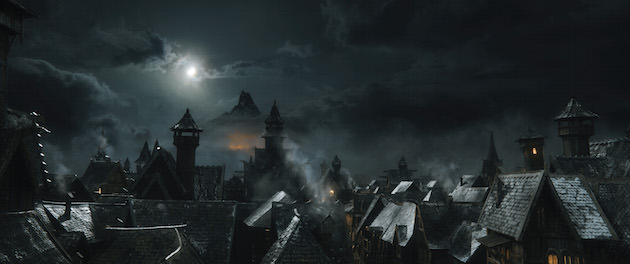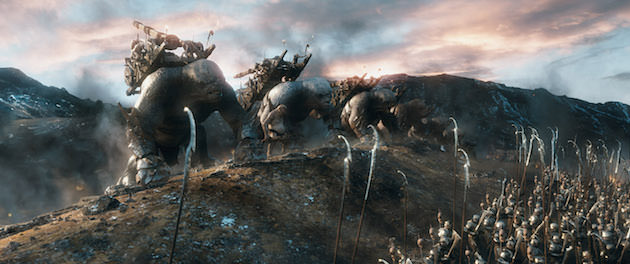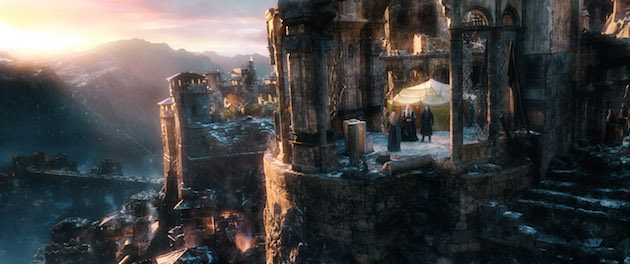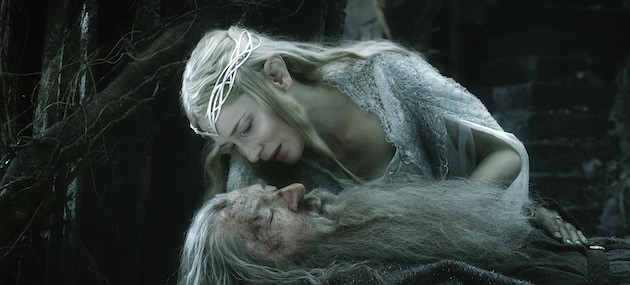Art Director for the Hobbit Battle of Five Armies
Building the Sets of Middle-Globe for The Battle of the Five Armies
Peter Jackson and his crew shot The Hobbit trilogy concurrently over 266 days (the aforementioned full number of days it took to shoot The Lord of the Rings trilogy). Some other ten weeks was needed for cast and coiffure for pickup shooting for The Battle of the Five Armies on the performance capture stage, which ends the Middle-earth saga that Jackson and his squad have been working on since concluding century.
Edifice the sets for Jackson's Hobbittrilogy required all eight acres of Rock Street Studios, on the Miramar Peninsula in New Zealand, also equally the vi audio stages. Building Tolkien'due south hyper-realized world into applied sets required the work of production designer Dan Hennah, supervising art director and gear up decorator Simon Bright and set decorator Ra Vincent, to name a few. They had the monumental task of designing and building the physical earth of The Hobbit trilogy in a way that would honor Tolkien's exquisite particular, aiming for the realistic and tactile. They were helped past Tolkien illustrators John Howe and Alan Lee, who have spent their entire careers developing a deeply researched, creative experience for the details of Middle-world, from the creatures to the cultures to the landscapes.

Howe and Lee have been channeling Middle-earth through their artwork for a long time, and their intuitive grasp of Tolkien's vibrant world was a major boon for the filmmaking team. "Their work excites the imagination and gave me a strong surround in which to imagine the story," cinematographer Andrew Lesnie said in the production notes. "I frequently showed Alan and John'due south work to the coiffure as a way of explaining the 'experience' of a location or a sequence. It was ever nice to pull off a shot that felt faithful to the tone of their work."

The creation of a film similar Battle of the Five Armies is not simply an adaptation of the source text, but hundreds of adaptations inside the production itself. Howe and Lee produced thousands of Middle-earth illustrations, which are then adapted by Hennah into detailed designs, which are and then adjusted into practical sets. The illustrations are adapted by costume designers Anne Maskrey and Bob Buck who wearing apparel the actors, and then those actors are filmed in 3D by Lesnie at 48-frames-per-second using Red Epic digital cameras, and that imagery is augmented with the visual splendors (and horrors) created by Weta Digital, and on and on it goes. Battle of the 5 Armies gave Jackson and his team the very all-time immersive technology they've ever had to work with, allowing for unprecedented flexibility in staging, framing and filming the final battle for Centre-globe.
And so how did they really build the sets for Middle-earth? First, Hennah'southward team created a virtual miniature of Tolkien's globe past building 94 models for the unabridged Hobbit trilogy, built in multiples of 1:sixteen or ane:25 scale. Once this was completed, the miniatures were transformed into life-sized sets for the film'southward most intense, or intimate, set pieces. For Battle of the V Armies, Hennah had 350 people transforming existing sets, as well every bit creating brand new sets for the third and final film.

One of these new sets that gets a much deeper look in this film is the ruined fortress of Dol Guldur. This abandoned castle is at the southern end of Mirkwood Wood, where Sauron was concluding defeated by the Elves, and where he re-emerges in The Hobbit trilogy to plot his revenge. Information technology'due south hither in Dol Guldur where Sauron summons the terrifying Ringwraiths, those black-clad entities that are actually nine long dead kings whom Sauron controls through his Rings of Power. And so conspicuously, Dol Guldur is an of import location.
The affair is, it wasn't described in detail in Tolkien's "The Hobbit," merely that didn't cease John Howe and Alan Lee from summoning the castle through the history Tolkien described in the appendices of his "The Lord of the Rings" trilogy. The design that emerged is based on an equilateral triangle, with three sides, three bays and three staircases on an interlinked facet. This formulation of information technology gave each Ringwraith it's ain chamber.
"The place is e'er a kind of reflection of the character of the people that live there, so nosotros knew it had to be very creepy, redolent of evil and the horrible, gruesome things that happen there," Lee said in the product notes. Howe and Lee's design was so taken by Hennah and his team and transformed into six sets that were aged and rotted to look ancient, fitted inside a stone structure and rusted metallic strapping. "This is an environment in which you immediately feel the evil that has nerveless there," Hennah said. "In that location are skeletal remains and everywhere you look are metal spikes, chains, and great, thorny vines—all of which immediately evokes a sense that something bad has taken identify here."
The adaptations within adaptations that took place during the production of The Battle of the Five Armies is mayhap best visualized hither at Dol Guldur. From Howe and Lee's artwork to Hennah and his team'due south blueprint and construction, to cinematographer Andrew Lesnie's employ of all those difficult angles in the three-side structure, to extra Cate Blanchett'due south arrival in this identify, where her grapheme Galdriel descends barefoot into this night, cold, evil place. Galdriel walks deeper and deeper into Dol Guldur's rotted stone center, wearing a flowing, white gown. The gown, of course, was created past costume designer Ann Maskrey, along with Bob Buck and Richard Taylor, who gave Galdriel an ethereal, celestial look that contrasted with the nighttime surroundings. The adaptations abounded during this production; Blanchett's dress was inspired by ballet dancer Margot Fonteyn'southward from "Ondine."

Source: https://www.motionpictures.org/2014/12/building-the-sets-of-middle-earth-for-the-battle-of-the-five-armies/
0 Response to "Art Director for the Hobbit Battle of Five Armies"
Enviar um comentário